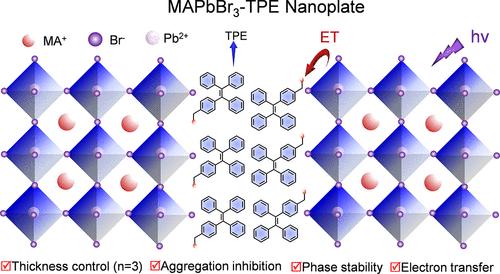溴化铵修饰四苯基乙烯对稳定CH3NH3PbBr3纳米板的厚度控制和聚集抑制作用
IF 8.2
2区 材料科学
Q1 MATERIALS SCIENCE, MULTIDISCIPLINARY
引用次数: 0
摘要
深蓝钙钛矿纳米板已成为潜在的发光材料。然而,钙钛矿薄片的光致发光和稳定性在很大程度上取决于其厚度和聚集状态。本研究通过调整CH3NH3+ (MA+)阳离子与溴化铵修饰的四苯基乙烯(TPE)的比例,有效地控制了MAPbBr3纳米片的厚度,从而控制了MAPbBr3纳米片的光致发光和聚集状态。具体而言,前驱体悬浮液中TPE含量增加,制备的纳米血小板厚度减小,量子尺寸效应增强。此外,具有较大位阻基团的TPE向外粘滞,抑制了纳米板在该维度上的聚集,形成了三层MAPbBr3-TPE纳米板。TPE与MAPbBr3之间形成氢键和静电相互作用,有助于防止相偏析,促进有效的能量传递。此外,水暴露、光照和中等温度显著增强了MAPbBr3-TPE的稳定性。通过合成的MAPbBr3-TPE在外界环境下的不同刺激反应制备光学防伪标签,对信息进行加密和解密。该研究为探索钙钛矿纳米板的稳定性、防伪等在先进光学智能技术中的应用奠定了基础。本文章由计算机程序翻译,如有差异,请以英文原文为准。

Thickness Control and Aggregation Inhibition Achieved by Ammonium Bromide-Modified Tetraphenylethylene for Stable CH3NH3PbBr3 Nanoplates
Deep blue-emitting perovskite nanoplates have become potential luminous materials. However, the photoluminescence emission and stability of the perovskite platelets are considerably dependent on the thickness and aggregation state. In this study, the ratio of the CH3NH3+ (MA+) cations and ammonium bromide-modified tetraphenylethylene (TPE) was tuned to effectually control the thickness and consequently the photoluminescence and aggregation state of the MAPbBr3 nanoplates. Specifically, the content of TPE in the precursor suspension was increased and the thickness of the produced nanoplatelets was reduced, bringing about the enhanced quantum size effect. Moreover, the TPE with a large steric resistance group stuck outward and restrained nanoplate aggregation in that dimension, inducing the formation of three-layer MAPbBr3-TPE nanoplates. The hydrogen bond and electrostatic interaction were formed between TPE and MAPbBr3, contributing to preventing phase segregation and facilitating an effective energy transfer. Furthermore, the stability of MAPbBr3-TPE was significantly strengthened by water exposure, light irradiation, and a moderate temperature. Optical anticounterfeiting labels were prepared through the different stimulus responses of the synthesized MAPbBr3-TPE in the external environment for encryption and decryption of information. This study lays a foundation for exploring the stability of perovskite nanoplates, anticounterfeiting, and other applications in advanced optical smart technologies.
求助全文
通过发布文献求助,成功后即可免费获取论文全文。
去求助
来源期刊

ACS Applied Materials & Interfaces
工程技术-材料科学:综合
CiteScore
16.00
自引率
6.30%
发文量
4978
审稿时长
1.8 months
期刊介绍:
ACS Applied Materials & Interfaces is a leading interdisciplinary journal that brings together chemists, engineers, physicists, and biologists to explore the development and utilization of newly-discovered materials and interfacial processes for specific applications. Our journal has experienced remarkable growth since its establishment in 2009, both in terms of the number of articles published and the impact of the research showcased. We are proud to foster a truly global community, with the majority of published articles originating from outside the United States, reflecting the rapid growth of applied research worldwide.
 求助内容:
求助内容: 应助结果提醒方式:
应助结果提醒方式:


